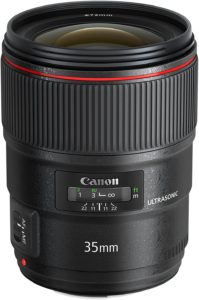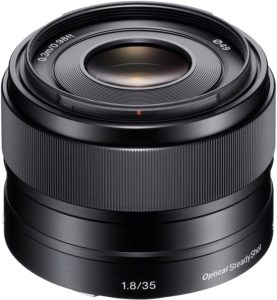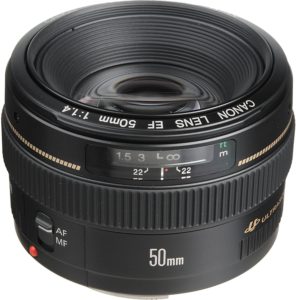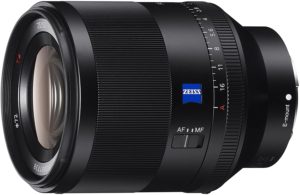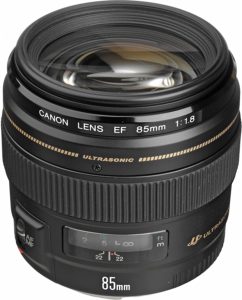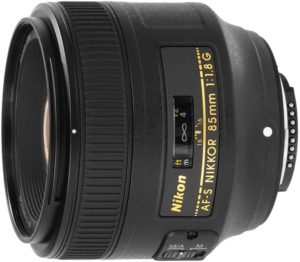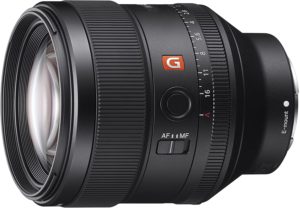If you’ve been into photography for some time now no doubt you’ve heard some good things about 35mm, 50mm, and 85mm prime lenses. This article should help answer any questions you have about each of them, their differences, and why you should get one over the others (or all three!).
A 35mm prime lens has a wide angle of view and is best for images that incorporate the background with the main subject. It also works well for landscape photography. A 50mm prime lens is a versatile portrait lens that can shoot both headshots and full-body shots while also giving you some distance from the main subject. It is known as a standard lens because it approximately resembles the angle of view we see with our eyes (however, a 35mm lens is more realistic). A 50mm also adds less wide-angle distortion to your main subject than the 35mm lens. An 85mm prime lens has a more narrow-angle of view than the 35mm and 50mm lenses and is known as the best portrait lens because it adds little, if any, facial distortion to your main subject. It also has a large enough focal length to help separate the main subject from the background than the other two lenses.
Choosing the right lens will depend heavily on which type of photography you will use it for. This article will explore the best uses for the 35mm lens and compare it to other common lenses. Hopefully, by the end, you’ll have be able to decide if you actually need a 35mm lens.
First, Some Terminology
When deciding on a camera lens, it’s beneficial to understand some terminology relating to lenses:
- What is the meaning of focal length?
- What is the difference between a prime lens and a zoom lens?
The Meaning of Focal Length
When deciding between lenses based on their focal length (35mm, 50mm, 85mm) it will definitely help to know the meaning of focal length and how it affects the images you shoot.
Lenses work by refracting light so that an image converges onto one point. This point is called the focal point of a lens, and it is a specific distance behind the lens itself. In a camera, the image sensor (or film plane) is placed right at this point. Generally, the distance between the back of the lens and the camera’s image sensor is called the focal length when focused at infinity. So, in a 35mm lens, the image sensor (or film plane) is 35 millimeters behind the glass lens.
So that does this mean for your photos?
Generally, a shorter focal length (like 35mm) will have a wider angle of view because more of the scene will be captured on the image sensor or film plane. This also means that a longer focal length (like 85mm) will have a more narrow angle of view because less of the scene will be captured on the image sensor or film plane. The focal length will also impact how much of the scene will be in focus and lens distortion to your main subject.
(You can read more about focal length in this article here ).
).
Prime vs. Zoom Lens
Knowing the difference between a prime lens and a zoom lens will also help you decide what you need for your photography goals.
The key difference here is the focal length. A prime lens is fixed at one focal length, while a zoom lens can be adjusted to shoot within a range of several focal lengths. So a zoom lens may be better suited for a photographer on the move who doesn’t want to stop and change lenses very often. Another difference is all prime lenses and some higher-end zoom lenses have constant apertures. This means when changing focal length, the aperture (or f-stop) doesn’t change. Some less expensive zoom lenses have variable apertures . This means as you zoom to the larger focal lengths, less gets into the camera and you may need to compensate with the ISO or shutter. This is noted on the lens itself with a range of apertures (for example, f/2.8 – f/5.6).
. This means as you zoom to the larger focal lengths, less gets into the camera and you may need to compensate with the ISO or shutter. This is noted on the lens itself with a range of apertures (for example, f/2.8 – f/5.6).
While zoom lenses are capable of producing great images and are versatile since they cover many popular focal ranges (for example, 24 – 70mm is a popular one for wedding photographers), they can be heavier than a prime lens and less compact. Prime lenses are lighter, more compact, and will produce sharper images ideal for high-quality prints since it has fewer glass elements than zoom lenses. Prime lenses do take a bit more effort on your part to frame up the image with your feet rather than zooming it in or out.
What To Shoot With A 35mm Lens
Now that we know what “35mm” means when you say a 35mm lens, let’s get into the nitty-gritty of this wide-angle lens. This focal length is particularly interesting because it is closest to the focal length of the human eye.
So what does that mean, exactly? The best way to describe it is that a 35mm lens will shoot a very close representation of what the photographer is physically seeing with their eyes. This angle makes the 35mm lens best suited for a few types of photography.
- Lifestyle/Travel photos
- Shooting Video
- Street Photography
- Architecture
- Fashion Photography
Lifestyle Photography With A 35mm Lens
The versatility of a 35mm lens is what will make it a great companion to any traveler. Because of its wide-angle, it makes a great “point and shoot” tool that will produce sharp images of the angle of just what the traveler is seeing.
is what will make it a great companion to any traveler. Because of its wide-angle, it makes a great “point and shoot” tool that will produce sharp images of the angle of just what the traveler is seeing.
Lifestyle and travel photography aims to place the subject of a photo in their environment, thereby capturing them living their lifestyle. A headshot with the streets in Paris blurred out of the background won’t do as well on a travel blog as a photo that incorporates that same scene into the composition. Think of it this way: a 35mm lens can take you from a photo of a woman to a photo of a woman in Paris. This again is made possible by the wide-angle of the lens.
Shooting Video With A 35mm Lens
Another great use for 35mm lenses when shooting video. Again, since the focal length is close to that of the human eye, what’s filmed on a 35mm will give the viewer a feeling of being there right in the middle of the action. This is desirable because it envelopes the viewer into the environment of the movie.
These are some of the best uses for a 35mm lens, but you may be wondering how it stacks up for some other photography genres. Let’s take a look at how a 35mm lens can work in the following settings:
- Weddings
- Fashion
- Landscapes
- Food Photography
- Newborn Photography
Shooting Weddings With A 35mm Lens
Shooting a wedding entirely on a 35mm lens is possible, according to this article . Here are a few features of a 35mm prime lens that make it favorable for wedding photography:
. Here are a few features of a 35mm prime lens that make it favorable for wedding photography:
- “Zooming with your feet” rather than your lens gives the images a more interactive and feel more “in the moment”.
- Versatile enough to shoot portraits when placing your subject directly in the middle to avoid lens distortion
- Low light capability and small size/weight of the shorter focal length helps to limit camera shake
- Captures the environment of the wedding. This helps tell the story of the image.
When shooting a wedding, you want to keep in mind the stages of the event, what you’ll need at each stage, and how a 35mm lens can meet those needs.
For images of the wedding party getting ready, the need to interact with your subjects instead of shooting from far away actually gives the photos a more “in the moment” feel, especially when using a prime lens. The fact that you need to interact with your subject in this way actually gives someone viewing your photos the feeling of actually being there in the room. Something to also consider is zoom lenses often need more distance between the subject and the lens to be able to focus, while prime lenses often have a shorter minimum focus distance.
The 35mm lens also has enough versatility to shoot portraits. Granted, it is better suited for smaller rooms. If you’re photographing an outdoor farm wedding, you may want a longer focal length… but for close portraits of the bride and groom, the 35mm will work just fine as long as they are in the center of the frame since this will avoid lens distortion. Another benefit of a wide angle lens is the ability to include more people in the frame. For example, this is important when taking photos of the entire wedding party, or the just families of the bride and groom. Just be mindful of how close your subjects get to the edge of your image to avoid lens distortion.
Sometimes during the ceremony, and definitely during the reception, you will find yourself in a low light situation. 35mm lenses typically have a larger aperture (for example, f/2 or f/1.8), which allows more light to get into the camera. This makes them handle low light situations better than a longer focal length lens.
Shooting fashion With A 35mm Lens
35mm lenses are pretty suitable for shooting fashion as well. The reason being their ability to place the subject in an environment. Fashion is very much about lifestyle, and the 35mm lens is the lens of choice for lifestyle photography. When shooting a model, you’ll want full body shots to capture what they’re wearing and you’ll want to place them elegantly in whatever setting you are shooting. A 35mm lens will help significantly with composition when shooting fashion by giving you the ability to shoot a model “living their life” in whatever clothes they are wearing.
Shooting Landscapes With A 35mm Lens
What makes 35mm lenses work for landscape photography is their wide angle. We’ve already discussed how the 35mm shoots pretty close to what you see with your own eyes, and that’s exactly what makes it good for landscapes. When you’re in nature, on top of a mountain soaking in a view, that’s exactly what you want to capture! Your view!
Shooting landscapes on a 35mm lens will give your viewers the same perspective that you had… now isn’t that what you wanted to share with them all along? The same can be said for cityscapes or street photography as well.
The bonus about 35mm lenses is, they’re light. If you’re shooting amazing landscapes, chances are you’ve traveled to get off the beaten path. This nifty, lightweight lens makes for a great travel companion.
Shooting Food With A 35mm Lens
35mm lenses are good for shooting things up close , especially 35mm macro lenses
, especially 35mm macro lenses . Macro lenses allow you to get very close to whatever you are photographing because they have a minimum focus distance. Zoom lenses are sometimes used when photographing food but if you are in a small area and don’t have the extra space then a 35mm macro lens will help. Also, the ability to shoot up close in crisp detail will have your viewers’ mouths watering.
. Macro lenses allow you to get very close to whatever you are photographing because they have a minimum focus distance. Zoom lenses are sometimes used when photographing food but if you are in a small area and don’t have the extra space then a 35mm macro lens will help. Also, the ability to shoot up close in crisp detail will have your viewers’ mouths watering.
Photographing Newborns With A 35mm Lens
Since 35mm lenses are smaller and lighter they are great for baby portraits as well because they are less intimidating to the “client” and can capture the environment as well. However, 35mm lenses are not so good with shooting up-close portraits. While it’s certainly possible to shoot newborn photos on a 35mm lens, Audrey Anne Photo has this to say about it:
has this to say about it:
“Do be wary of the fact that the wider angle lens produces distortion if you are up close, so this lens is better for when you are stepped back a bit.”
How To Shoot With A 35mm Lens
A few things to note when shooting with a 35mm lens:
- The angle of your lens relative to your main subject matters
- The distance from your main subject matters.
- How does a cropped sensor (small than full frame) affect your 35mm lens?
The following tips are going to mostly relate to portraits and lifestyle photos of people.
and lifestyle photos of people.
Remember that because it’s a wide-angle lens, the 35mm will distort your subject if you aren’t shooting them in the center of your frame or straight on. The angle of your lens should be parallel to the ground or angled slightly down towards the ground.
The closer you get to your subject, the more pronounced the lens distortion will be. A good rule of thumb is to distance yourself such that at least half the subject’s body is in the frame. This is where a prime lens will help.
By requiring you to physically position the camera at the right distance from the subject, you’ll be forced to get deliberate when composing and this will keep you mindful of any potential distortion.
If you want to squeeze a little more out of your 35mm lens, you can use a camera with a crop sensor (also known as APS-C sized sensor). A 35mm lens on a camera made for a full-frame camera (for example, Canon EOS 5d Mark IV) with a crop sensor will feel like you are shooting a lens with a 56mm focal length. This is because the smaller sensor is getting less of the image projected from the back of the lens. Be mindful here though, because while the smaller sensor will help with distortion at the corners of your frame, it won’t protect you from making your subject’s nose look bigger if you get too close.
(also known as APS-C sized sensor). A 35mm lens on a camera made for a full-frame camera (for example, Canon EOS 5d Mark IV) with a crop sensor will feel like you are shooting a lens with a 56mm focal length. This is because the smaller sensor is getting less of the image projected from the back of the lens. Be mindful here though, because while the smaller sensor will help with distortion at the corners of your frame, it won’t protect you from making your subject’s nose look bigger if you get too close.
So, Do I Need A 35mm Lens?
If you’re looking for the right lens to document your travels, then the answer is yes. This lightweight lens’s versatility makes it a great companion to anyone taking photos as they travel. The answer is again, yes, if you are shooting environmental portraits, fashion, lifestyle photos for blogs, weddings, Food (with a macro), or marketing campaigns.
This is also a good lens for someone looking to expand their gear kit but isn’t quite sure they have a specific purpose in mind for it. The versatility of the 35mm lens will also definitely play nice with a curious photographer looking to experiment.
Good 35mm Lens Options
Here’s a few solid options for a 35mm lens by camera maker:
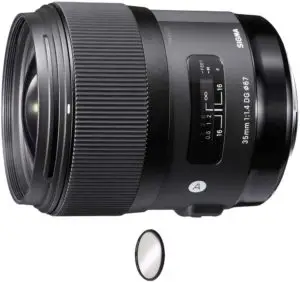
- Sigma 35mm F1.4 Art DG HSM (For Nikon Cameras)
What To Shoot With A 50mm Lens
We’ve seen what a shorter focal length can do, so how about the next step up? The slightly longer focal length can provide a shallower depth of field , which can help make your subject pop from the background. However, the standard focal length still allows for some “wide” shots.
, which can help make your subject pop from the background. However, the standard focal length still allows for some “wide” shots.
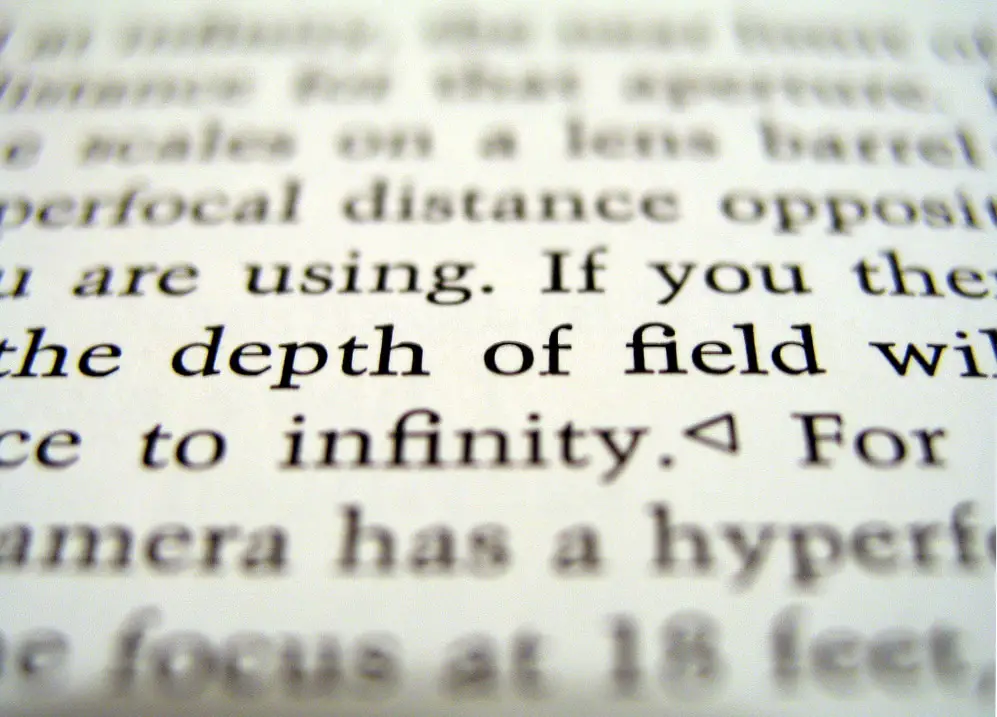
A slightly shallower depth of field produces nice bokeh (pronounced (BOH-kay and is Japanese), a photography term for the blurred areas that are out of focus in the foreground or background of an image with a shallow depth of field.
Bokeh works to elegantly isolate your subject from the environment, making the 50mm lens a very good portrait lens. Like the 35mm, it’s versatile in its own regard, and can be used to shoot a number of different subject types.
Shooting Portraits With A 50mm Lens
As mentioned above, the longer focal length of this lens will produce areas in the background out of focus that isolate your subject when using a large aperture (for example, f/1.8)
Another benefit of this lens is that there will be less distortion than the 35mm when composing photos closer to your subject. This is a good lens for images of your subjects from the waist up, but will still work for full body images but you won’t be able to incorporate as much of the environment in your composition as with a 35mm lens. This could be a good thing if your environment doesn’t add anything to the narrative of your image. This also makes the 50mm lens one of the most versatile lenses.
Shooting Weddings With A 50mm Lens
Why would a lens that’s great for shooting portraits work well for a wedding, too?
Well… wedding portraits. If you’re shooting a wedding, chances are you’ll be shooting portraits of at least the wedding party. What makes the 50mm a solid wedding portrait lens over an 85mm is that it can still work in slightly tighter quarters and include more of the background. Also, because a 50mm lens has a shorter minimum focus distance than a 85mm lens, you won’t have to worry about having enough room to stand back and get the shot.
Also, the fact that a 50mm lens shoots half or three-quarter body shots is a good to have for portraits but even better for portraits. While the bride’s face will most likely be beaming, you’ll definitely want to use this lens to show off her gown. This also applies to the groom and the rest of the wedding party. A 50mm lens will capture their outfits along with their smiles.
Shooting fashion With A 50mm Lens
Speaking of capturing outfits, how can you use a 50mm for fashion too? We’ve already mentioned that the 35mm is good for shooting the lifestyle aspect of fashion because it captures alot of the environment as well, but if you’re looking to specifically show the detail of the clothing itself, then a 50mm lens may be more suitable. The 50mm focal length allows for full or 3/4 body shots without the unflattering distortion of a 35mm lens when shooting the same composition. In fact, if composed properly, the 50mm may actually create a desirable slimming effect on your subjects when shooting slighting up or down.
on your subjects when shooting slighting up or down.
Consider online shopping, too. A lot of sites shoot photos of their models from the neck down. A 50 mm lens can achieve this composition without distorting the model’s arms and legs too much. The same goes for a situation where you’re shooting from the waist up.
Shooting Landscapes With A 50mm Lens
A 50mm prime lens is a solid option when image sharpness is the name of the game. While the 50mm does not offer as wide an angle as the 35mm, it can provide razor-sharp images. This is desirable when shooting a landscape full of nuances and details.
Also, what you give up in angle width can always be made up for in post. One easy way to get wide angle shots with your 50mm prime lens is to stitch a series of images together to create a panorama . In most cases, this will give an even wider angle than the 35mm lens, with the added sharpness of the 50mm. Best of both worlds.
. In most cases, this will give an even wider angle than the 35mm lens, with the added sharpness of the 50mm. Best of both worlds.
Shooting Food With A 50mm Lens
The 50mm may be a better option for food photography than the 35mm again because of the lower lens distortion. One way to reduce distortion even further is by shooting a wider composition with your 50mm lens, then cropping to the main subject in post-processing. This will crop out the corners of the frame where distortion is highest (yet still less noticeable with a 50mm).
even further is by shooting a wider composition with your 50mm lens, then cropping to the main subject in post-processing. This will crop out the corners of the frame where distortion is highest (yet still less noticeable with a 50mm).
The 50mm prime lens also shares the same low light capability as the 35mm prime. This makes for more brilliant food shots, even when in dimly lit restaurants.
Photographing Newborns With A 50mm Lens
A 50mm lens on a full-frame camera will be a great all-around option when shooting photos of newborn babies. Newborn photos are essentially still portraits, just with a smaller, cuter subject. The 50mm on a full-frame gives a similar “what the eye actually sees” view as the 35mm lens, but without as much distortion.
Further, when shooting newborns, you and your viewers are more interested in the subject, and less the environment… which will mostly just be blankets and pillows. A 50mm prime lens will serve as a good all-around tool for this subject, but it may be worth looking into a 50mm macro lens for the really close up shots.
How To Shoot With A 50mm Lens
The 50mm is heralded as the “nifty fifty” for reasons built right into the nickname. It’s versatile and you can shoot a little bit of everything on it, so remember these tips while wielding the 50mm:
while wielding the 50mm:
- Take a step back from your main subject
- Shoot in open spaces
- Use a large aperture like (f.2.8) for a shallow depth of field to create beautiful bokeh
Get familiar with your lens’s minimum focusing distance. For most 50mm prime, this is generally just over one foot away (about 14 inches) Practice shooting at different distances to find your particular lens’s minimum focus distance, because it will vary slightly by manufacturer and model. This is important to know because shooting a subject from closer than this distance will make them appear blurry and out of focus even if the rest of your settings are correct.
Shooting outdoors and in open spaces will give you the freedom to step back and shoot your subject from different distances. You’ll also need more room to compose your shots since the 50mm has a more narrow viewing angle (relative to the 35mm).
- On a full-frame camera, your viewing angle will be about 46°
- With a crop sensor, that viwing angle shrinks down to around 30°
So you’ll need to step back a bit, not only to ensure your lens will focus but to be able to compose your shots. Taking a few steps back and composing your image from further away allows you to utilize the 50mm prime lens’ narrow depth of field to create stunning bokeh. Distance from your subject and aperture are the factors at play when tastefully blurring out the background. Keep in mind that as the aperture increases, your distance from the subject must also increase to create the same quality of bokeh.
The 50mm prime lens is a workhorse for many photographers; another nice thing about it is that it’s a more budget-friendly lens option.
Good 50mm Lens Options
A few of the top 50mm lenses include:
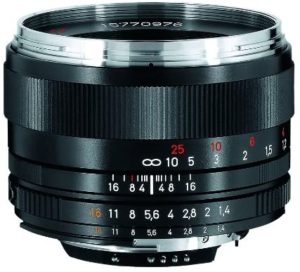
- Zeiss Milvus 50mm f/1.4 ZF (Nikon)
What To Shoot With An 85mm Lens
Not as versatile as the 35mm or the 50mm, but if you’re in the business of shooting portraits, this is the specialty lens. With the longest focal length on this list, it can provide the thinnest depth of field. This will produce intense bokeh that pretty much blends the background of your composition into a structureless swath of colors, which help to make your main subject pop from the background.
Contrast that with razor-sharp images of your main subject and there’s no doubt where your viewer will look to first.
Shooting Portraits With A 85mm Lens
The 85mm focal length may not be as versatile for portrait shooting as the 50mm, but what it lacks in versatility it makes up for with its ability to produce marvelous head shots. This focal length generally has a longer minimum focus distance than the 35mm and 50mm, which will require you to stand much farther from your subject. However, this creates a couple of benefits when shooting head shots:
- Shallow depth of field for amazing bokeh that makes your main subject pop from the background
- Little to no lens distortion
We’ve already touched on this lens’s depth of field a bit, but the second benefit of an 85mm focal length is the lack of image distortion. This is a big deal when shooting head shots, and your subjects will love you for it.
Shooting Weddings With A 85mm Lens
Weddings require a well-rounded photographer to capture a variety of types of images in different settings. While it’s not recommended to shoot a wedding only on an 85mm lens, it is definitely a tool that pros have in their kit and can be helpful when you need the extra reach (for example, during the ceremony). An 85mm or longer focal length can help you capture images with more of the bride and groom’s personality because the minimum focus distance of the 85mm requires the photographer to be far away. This gives the bride and groom some space so they can actually focus on each other and forget about the camera.
Shooting fashion With A 85mm Lens
The 85mm’s ability to shoot sharp, close cropped images makes it a worthwhile tool to invest in for fashion photography as well.
The sharpness allows you to capture the details of not only the subject’s clothing, but also details of their jewelry, hair, or makeup. You will need to stand farther back from your model, but in a studio or even outdoors, you are not so far away that communicating with them becomes impossible. Just a bit more challenging.
Shooting Landscapes With A 85mm Lens
There’s no doubt that the 85mm lens is a portrait lens through and through, but that doesn’t mean it can’t create some stunning landscape photos.
A good use for the 85mm lens when shooting landscapes is placing a subject in the foreground. Instead of “here’s a photo of some mountains” think “here’s a photo of a person soaking in the view of those mountains.” Granted, you’ll need to be further away to shoot a photo like that, but you already hiked miles to get to your view, what’s another 100 feet?
for the 85mm lens when shooting landscapes is placing a subject in the foreground. Instead of “here’s a photo of some mountains” think “here’s a photo of a person soaking in the view of those mountains.” Granted, you’ll need to be further away to shoot a photo like that, but you already hiked miles to get to your view, what’s another 100 feet?
Another benefit of shooting from far away allows you to shoot wildlife without disturbing the animals. Depending on which wildlife you’re photographing, you might not want to get to close anyway!
you’re photographing, you might not want to get to close anyway!
Shooting Food With A 85mm Lens
While definitely not the lens of choice for food photography, a skilled photographer can still work to its strengths . Two of which are a narrow viewing angle and large aperture.
. Two of which are a narrow viewing angle and large aperture.
The narrow viewing angle lends itself nicely to minimalist composition. It forces the photographer to clearly define one subject of the photo. This can tell a different story than a wider angle of a buffet table full of food. Low light capability is a plus when photographing food since it is mostly taken indoors or near a window. An 85mm prime lens will typically have a larger aperture (for example. f/2.8), which equates to more light into the camera and, therefore, better images.
Photographing Newborns With A 85mm Lens
Newborn portraits are… portraits. The 85mm lens is a portrait lens. Need we go further? An 85mm lens will shoot great newborn photos for all the same reasons it will shoot great head shots of adults. If you’re building a kit for newborn photography, it may be worth looking into a macro lens to magnify the main subject a bit.
How To Shoot With An 85mm Lens
One thing you’ll notice the first time you shoot on an 85mm prime lens is how far back you need to stand. A few tips for using this focal length:
- Adjust your composition accordingly
- Mind the narrow depth of field
- Be mindful of camera shake
An 85mm lens will shoot cropped compositions instead of a wide angle like a 50mm or 35mm lens, so use it that way and work with its strength, not against it.
The narrow depth of field will force you to take extra care when focusing your shot unless you’ve purchased a lens with auto-focus capability. Even still, be mindful of what’s in focus and what’s not.
85mm camera lenses suffer from camera shake more often than short focal length lenses (like 35mm). This is when even through your main subject is in focus, your image appears blurry or out of focus. Luckily, there are two ways to avoid camera shake when dealing with a zoom lens.
- The method I most commonly use is to set your shutter speed the same or faster than your focal length. For example, if you are using a 85mm lens then your shutter should either be 1/85th of a second or faster to avoid blurry photos caused by camera shake.
- Use a steady mono– or tripod if you are planning on using a long zoom lens like a telephoto or super-telephoto lens to help make sure you can keep the camera steady to snap a clear image.
I recommend using both methods when you want a sharp image and actively trying to avoid camera shake. However, if you aren’t able to use a mono- or tripod then setting your shutter speed equal to or more than your focal length is your best option
Good 85mm Lens Options
Some of the best 85mm options include:
So, Which One Is for You?
Hopefully, the information in this article helps you answer the question of: Do I need a 35mm lens?
Or maybe a longer focal length of 50mm or 85mm is better suited for your intended use. Either way, when deciding on a lens, it’s important to weigh the lens’s strengths against what your intended use for it will be.

